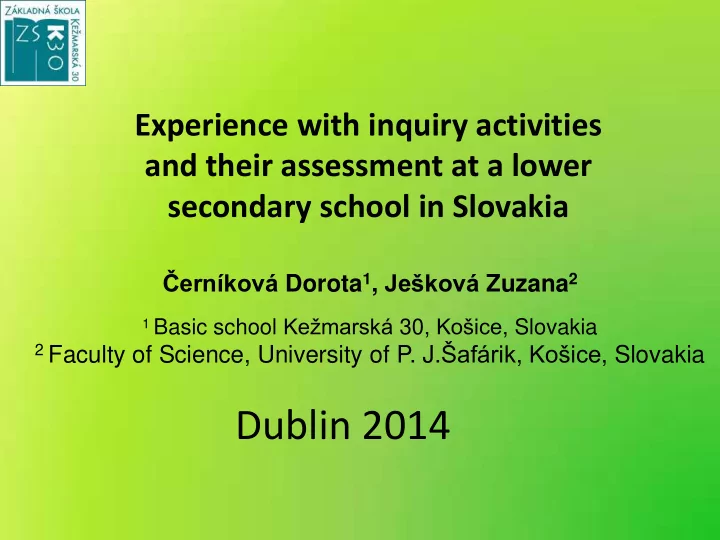

Experience with inquiry activities and their assessment at a lower secondary school in Slovakia Černíková Dorota 1 , Ješková Zuzana 2 1 Basic school Kežmarská 30, Košice , Slovakia 2 Faculty of Science, University of P. J. Šafárik , Košice , Slovakia Dublin 2014
Contents • Introduction • How we implement and assess IBSE at lower secondary level • Examples of inquiry activities and its assessment • Conclusion
Introduction • School reform in Slovakia have started since 2008 • The state education programme and school education programme • Spiral way of building knowledge and skills was replaced by teaching blocks of topics • The main part of education in physics is active pupils ´ learning based on experimentation with elements of inquiry (textbooks)
How we implement IBSE • Our school tries to carry out activities that support ideas of IBSE • Types of activities – regular textbook activities, home assignments – special science events, e.g. science open day for parents, science lessons for elementary school pupils, science conference at school or at science institution – activities in cooperation with science institutions
How we assess IBSE in school The assessment of pupils work in the regular school activities based on the following ideas: • Designing an experiment • formulating of hypotheses about a problem • conducting an experiment, • searching for information from internet or books • the pupils ´ ability to cooperate and work in a group
How to melt chocolate • home assignment • the aim was to find the best way how to melt chocolate and find out the melting point • Written report (Tools, steps of procedure, explanation, conclusion) • Peer assessment by pupils from the same class who did not know the names of assessed friends, • they used 5 scaled rubrics
Which objects conduct electric current SAILS activity Each pupil wrote a written report • the concept map, design of experiment, • Choosing tools • Tablet with different objects and of different materials (tea spoon of metal, plastics, piece of wood, scissors, etc.) • hypothesis on conductivity (conducts well, poorly, not at all) • The experiment and comparing the results of experiment with hypothesis • Essay with topic Why is electric current important for our life
Assessing IBSE in cooperation with science institutions The assessment of pupils work in the project activities in cooperation with Slovak academy of Science and University based on the following ideas: • attitude towards the inquiry activity, enthusiasm, drive, • ability to work in a group • level of knowledge, skills, • planning investigation and collecting data • search for information and presenting them • explaining knowledge in front of different audience
Human and horse hair • In cooperation with the Institute of Physics, Slovak Academy of Science, 15 pupils of 7 th and 8 th grade. • Pupils compared the shapes of the human and the horse hair, its thickness, load capacity and extention under different applied forces .
The pupils work on the project was assessed by teacher and by scientist who cooperated on this project . This assesment was based on • work with the apparatus • the level of presentation and argumentation within the discussion at the science conference
How crystals grow • in cooperation with the Technical University and with Slovak academy of science The project involves : • the visit of the University mineralogical collection. • Creating own different colour crystals made by evaporating saturated water of salt solutions • investigated the properties of crystals (shape, crystalline structure, colour, etc.) • present the results at pupils’ science conference.
This project was assessed by teacher and also by scientist , who cooperated on this project . The evaluation was based mainly on activity of pupils, their level of knowledge, of the level of presentation on conference
How noisy is our school and its neighbourhood • in cooperation with University • the sound level meter.. The project consisted of inquiring : • the noise at school -voice of teacher, noise of PC, school corridor, etc • noise at home - washing machine, refrigerator, etc • the noise in the supermarket - air condition, fountain, elevator, etc. • the noise on a street and means of transport - quiet and noisy street, tram, bus and bus station, etc.
The assessment of the project was based also on • the pupils ´ creativity, • originality in exploring different noise • tabular and graphical evaluation of the noise level • suggestions on protection against noise
CONCLUSION • The physics became more interesting for pupils but also for teachers. • Pupils look forward to these lessons. • Physics became more fascinating not only for pupils who like physics, but also for the others who were inspired by science presentations of their peers.
Recommend
More recommend